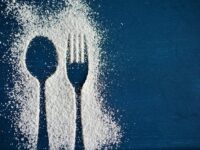You may have been warned to stay away from fatty foods, eat fat-free, or cut fat from your diet, but just 100 years ago companies were heralding a new type of fat as the food of the future, a healthy addition to all meals and necessary for a balanced diet. This new fat was hydrogenated fat, known today as trans fat or trans fatty acid.
Hydrogenated fat got its name from a process called hydrogenation. In 1897, French chemist Paul Sabatier discovered metal catalysts could be used to create hydrogenation reactions to manually add hydrogen atoms into chemical structures. Building off this discovery in 1901, German chemist Wilhelm Normann successfully used this reaction to hydrogenate liquid fat into a special semi-solid fat, today known as trans fat or saturated fat depending on the locations of hydrogen.
There are two broad categories of fats, saturated and unsaturated. Saturated fat is when every carbon on the chain has two hydrogen atoms bonded to it with single bonds. This fat is found in butter or other solid, naturally occurring fats. Unsaturated fats are when some carbons in the chain don’t have two hydrogen bonds so adjacent carbons form double bonds to become stable. These double-bonded carbons can have two orientations, cis and trans. Cis occurs when the hydrogens are on the same side of the carbon backbone and are in vegetable oils or fat found in nuts. Trans occurs when the hydrogens are on different sides of the carbon backbone, found in margarine or manufactured butter, and holds the fat in a semi-solid state at a large range of temperatures. This was the fat Wilhelm created, and it was an overnight hit.
In a time of economic depression where fresh food and natural fats, like animal fat and butter, were especially rare, trans fats could be easily and cheaply made from vegetable oil.
Popularity soared during the 1930s. In a time of economic depression where fresh food and natural fats, like animal fat and butter, were especially rare, trans fats could be easily and cheaply made from vegetable oil. So manufacturers switched from natural animal fat to trans fatty acid. Soon, they discovered that because of its semi-solid properties, trans fats extended the shelf life of foods and were better at fat frying because of an increased melting point. By World War II, trans fats were used in almost all packaged foods and kitchens, its popularity aided by butter and animal product rationing during the war. Trans fats were marketed as healthier since they were made in a lab, not produced by fatty animals. At this point you might be wondering — when does fat become the villain?
Trans fats were marketed as healthier since they were made in a lab, not produced by fatty animals. At this point you might be wondering — when does fat become the villain?
The miracle of trans fats was debunked in the 1980s and 1990s when studies, spurred by a national obesity epidemic, found trans fats not only increased the levels of the most harmful serum cholesterol, low-density lipoprotein (LDL) cholesterol but also lowered the amount of the most helpful cholesterol, high-density lipoprotein (HDL) cholesterol. The harmful LDL cholesterol clogs arteries and can cause heart attack and stroke after excessive buildup. A study of 85,095 women over the course of eight years found that women with a higher intake of trans fatty acids had increased levels of LDL cholesterol and were more likely to develop heart disease, the leading cause of death in America.
Trans fats are a stellar example of what public policy and consumer awareness can do. In 2006 new U.S. Food and Drug Association (FDA) labeling regulations required manufacturers to report grams of trans fats per serving. Customer awareness created a consumer selection against trans fats that drove manufacturers to lower the levels of, or completely remove, trans fats in foods. The Centers for Disease Control and Prevention found Americans’ trans fat blood-levels dropped 58 percent from 2000 to 2009.
The miracle of trans fats was debunked in the 1980s and 1990s when studies, spurred by a national obesity epidemic, found trans fats not only increased the levels of the most harmful serum cholesterol, low-density lipoprotein (LDL) cholesterol but also lowered the amount of the most helpful cholesterol, high-density lipoprotein (HDL) cholesterol.
Then in 2015, the FDA moved to ban all partially hydrogenated oils, the food-manufacturing term for trans fats, by marking them as no longer “generally recognized as safe.” The ban was set to go into effect on June 18, 2018 but was pushed to January 1, 2020 because of time extensions for food manufacturers to find alternatives.
The next big “miracle food” diet might be worth a second look. Just 100 years ago, trans fats were considered a scientific miracle. It wasn’t until the 1990s that scientists found its effects, so it is critical to think critically about new fads.
Sources: 1
Image Source: Flickr






